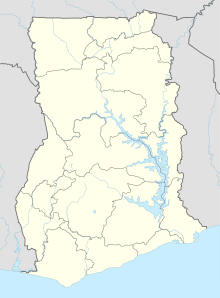Fort Nassau (Ghana)
Coordinates: 5 ° 8 ′ 0 ″ N , 1 ° 12 ′ 0 ″ W.
Fort Nassau was the first Dutch fortress on the Gold Coast , changed hands several times and is still in ruins today.
As early as 1595 (? 1598) the Dutch had set up an unfortified trading post (trading post) for trading gold on the site of what would later become Fort Nassau near Mori (or Moure). After the Portuguese attacked this station in 1610 and burned the village in front of it, the king of Asebu (or Sabou) sent two ambassadors to the Netherlands with the request to build a fortified fort on his territory. The Dutch followed this request, sent a ship with craftsmen and building materials straight to Mori and built their first fort there on the Gold Coast. In order not to give the Portuguese a chance to interfere there again, the bricks for the construction of the fort were brought in completely from the Netherlands. The fort was also built entirely in the local style by the Dutch, who were not very familiar with the local requirements for the construction, and was therefore considered an extremely unhealthy, poorly ventilated structure. From 1612 to 1637 (until Elmina was conquered by the Portuguese) the fort was the headquarters of the Dutch on the Gold Coast. In 1615 another attack by the Portuguese was successful and led to the partial destruction of the complex. In 1624 the fortress - which had since been taken over by the Dutch West India Company - was rebuilt significantly enlarged. In 1645 there was a Dutch crew of 32 men with a garrison commander, a doctor, a coppersmith and 156 slaves. In 1664 the British briefly took over the fort, in 1665 the Dutch again and in 1782 the British conquered it again. In 1785 it came back to the Dutch by contract (in exchange for the fort in Sekondi ). At the beginning of the 19th century it was abandoned for a few years and in 1868 in connection with a major exchange of rings between Dutch and British fortresses on the Gold Coast it was British for the last time.
See also
literature
- Albert van Dantzig: Forts and Castles of Ghana . Sedco Pub Ltd, Accra 1980, ISBN 9964-72-010-6 (Reprinted: ibid 1999).



